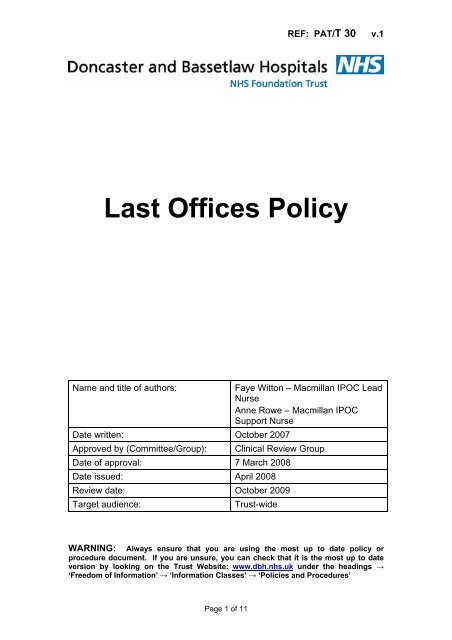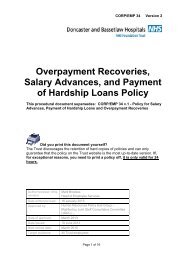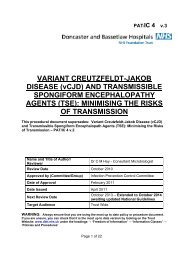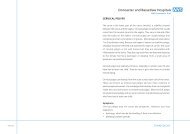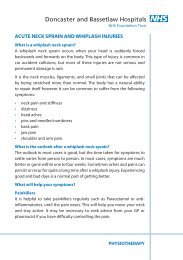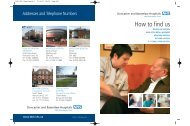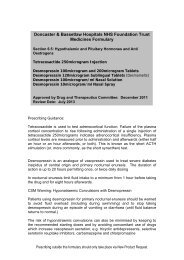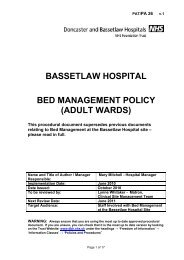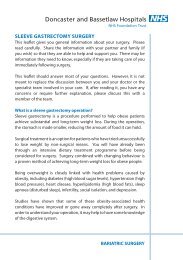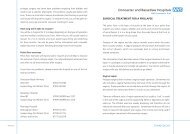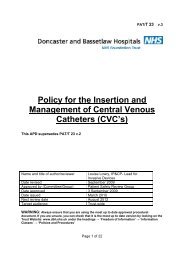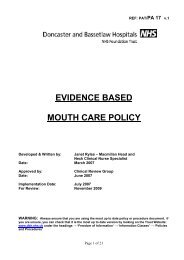Last Offices Policy - Doncaster and Bassetlaw Hospitals NHS ...
Last Offices Policy - Doncaster and Bassetlaw Hospitals NHS ...
Last Offices Policy - Doncaster and Bassetlaw Hospitals NHS ...
You also want an ePaper? Increase the reach of your titles
YUMPU automatically turns print PDFs into web optimized ePapers that Google loves.
Page 1 of 11<br />
REF: PAT/T 30 v.1<br />
<strong>Last</strong> <strong>Offices</strong> <strong>Policy</strong><br />
Name <strong>and</strong> title of authors: Faye Witton – Macmillan IPOC Lead<br />
Nurse<br />
Anne Rowe – Macmillan IPOC<br />
Support Nurse<br />
Date written: October 2007<br />
Approved by (Committee/Group): Clinical Review Group<br />
Date of approval: 7 March 2008<br />
Date issued: April 2008<br />
Review date: October 2009<br />
Target audience: Trust-wide<br />
WARNING: Always ensure that you are using the most up to date policy or<br />
procedure document. If you are unsure, you can check that it is the most up to date<br />
version by looking on the Trust Website: www.dbh.nhs.uk under the headings →<br />
‘Freedom of Information’ → ‘Information Classes’ → ‘Policies <strong>and</strong> Procedures’
<strong>Last</strong> <strong>Offices</strong> <strong>Policy</strong><br />
Contents<br />
Page 2 of 11<br />
REF: PAT/T 30 v.1<br />
Introduction 3<br />
Legal Requirements 3<br />
Cultural Requirements 3<br />
Infection Control 4<br />
Equipment 4<br />
Page<br />
Procedure 4-5<br />
Rapid release of bodies 6<br />
Duties <strong>and</strong> responsibilities of professionals performing <strong>Last</strong><br />
<strong>Offices</strong><br />
Education, training <strong>and</strong> support 6<br />
Audit 6<br />
Appendix 1 – Cultural <strong>and</strong> religious variations 7-8<br />
Appendix 2 – Guidelines for h<strong>and</strong>ling cadavers with infectious<br />
disease<br />
References 11<br />
6<br />
9-10
Introduction:<br />
<strong>Last</strong> <strong>Offices</strong> <strong>Policy</strong><br />
Page 3 of 11<br />
REF: PAT/T 30 v.1<br />
<strong>Last</strong> <strong>Offices</strong> is the care given to a deceased patient which demonstrates our<br />
respect for the dead <strong>and</strong> is focused on maintaining privacy <strong>and</strong> dignity,<br />
fulfilling religious <strong>and</strong> cultural beliefs, <strong>and</strong> upholding health <strong>and</strong> safety<br />
requirements. This nursing procedure is also known as ‘laying out’. This<br />
policy describes the care that is given when a patient dies to prepare the body<br />
for transfer to the mortuary. A literature review was carried out to guide this<br />
policy. With regards to packing, there was scant evidence within the<br />
literature; therefore the guidance has been developed on consensus of good<br />
practice.<br />
Performing last offices is the final demonstration of respectful, sensitive care<br />
that nurses offer patients <strong>and</strong> their families. It enables families to be aware<br />
that care <strong>and</strong> respect is ongoing after death, <strong>and</strong> also allows both health care<br />
professionals <strong>and</strong> family members the opportunity for closure in the<br />
relationship, which can be helpful in the bereavement process. Families may<br />
wish to spend time with their loved one on the ward after death prior to <strong>Last</strong><br />
<strong>Offices</strong> being performed. In this situation, the body should be repositioned<br />
<strong>and</strong> the environment tidied, in order to allow this time to be dignified <strong>and</strong><br />
peaceful.<br />
Legal requirements:<br />
If a patient has died unexpectedly, or if the coroner is to be informed for any<br />
reason, a post mortem examination will probably be required. Examples of<br />
such situations include sudden death, death after invasive procedure (e.g.<br />
surgery or endoscopies) or patient with industrial disease (e.g.<br />
mesothelioma). If you are unsure as to whether a post mortem will be<br />
required, consult with the medical team who can confirm whether they will<br />
issue a death certificate or whether the case needs to be referred to the<br />
coroner. If a post mortem is required leave all tubes/drains/lines in place <strong>and</strong><br />
spigot any catheters/cannulae.<br />
Cultural/Individual requirements:<br />
Practices relating to last offices may vary according to religious <strong>and</strong> cultural<br />
needs. Brief information regarding these variations is included within this<br />
policy, however further information is available from the chaplaincy<br />
department. See appendix 1 for cultural variations.<br />
It is good practice to sensitively discuss <strong>and</strong> document the patient’s wishes<br />
prior to death if the opportunity presents.
Infection control:<br />
Page 4 of 11<br />
REF: PAT/T 30 v.1<br />
St<strong>and</strong>ard precautions should be used with all patients. Leakage of bodily<br />
fluids creates an infection control risk; therefore steps should be taken to<br />
avoid this. There are some situations which require extra caution when<br />
preparing a body for the mortuary, <strong>and</strong> a body bag may need to be used.<br />
Please see appendix 2 for guidance on which diseases require use of a body<br />
bag.<br />
Equipment:<br />
• Bowl, soap, face cloths, towel, razor, comb<br />
• Mouth care pack/toothbrush<br />
• None absorbent cotton wool<br />
• Shroud (or own clothes if specifically requested by family)<br />
• Two identification bracelets<br />
• Dressing pack/dressings/tape<br />
• Body bag (in event of actual/potential leakage of body fluids or<br />
infectious disease)<br />
• Property book <strong>and</strong> property bag<br />
• Net pants <strong>and</strong> pad<br />
• Clean sheets<br />
• Gloves <strong>and</strong> apron<br />
Procedure:<br />
1. Either medical staff or a senior nurse must verify the death, <strong>and</strong> this<br />
should be documented in the patient’s notes. Medical staff must verify<br />
an unexpected death.<br />
2. Two members of staff should carry out <strong>Last</strong> <strong>Offices</strong>.<br />
3. Offer support <strong>and</strong> information to family/carer regarding the procedure<br />
after death.<br />
4. Sensitively explain to other patients in the area that a patient has died,<br />
in order to allay misconceptions <strong>and</strong> fears.<br />
5. Ensure adequate privacy <strong>and</strong> dignity whilst performing last offices.<br />
6. Wear gloves <strong>and</strong> apron.<br />
7. Position the patient on his/her back leaving one pillow in place.<br />
Support the jaw with a pillow or rolled up towel, to enable the mouth to<br />
close. Straighten the limbs, <strong>and</strong> align in a natural position with arms at<br />
the side.<br />
8. Close the patient’s eyes, if possible, by applying light pressure to the<br />
eyelids.<br />
9. Press on the lower abdomen to empty the bladder (unless post mortem<br />
is required, when bladder should be left full for toxicology).<br />
10. Remove any mechanical aids such as syringe drivers.<br />
11. Remove any sharps such as butterfly needle <strong>and</strong> dispose of carefully.<br />
12. Remove drainage tubes <strong>and</strong> document any tubes remaining such as<br />
Hickman lines. (If a post mortem is required leave all tubes in situ)
Page 5 of 11<br />
REF: PAT/T 30 v.1<br />
13. Leave any cannulae in situ, cover <strong>and</strong> tape. This will prevent<br />
unnecessary leakage of bodily fluids.<br />
14. Wash the patient in accordance with religious/cultural needs. Shave<br />
male patients if necessary. Family/carers may wish to assist in this as<br />
a final act to demonstrate their love <strong>and</strong> care for the patient.<br />
15. Clean the patient’s mouth <strong>and</strong> teeth. If possible put patient’s dentures<br />
in, if not send the dentures to the mortuary with the body <strong>and</strong> document<br />
this.<br />
16. Remove the patient’s jewellery <strong>and</strong> document in valuables book. If<br />
family request that certain jewellery (e.g. wedding ring) be left on body,<br />
this should be documented on the notification of death form. A second<br />
member of staff should witness this. Rings should be taped for<br />
protection.<br />
17. Pack throat with none absorbent cotton wool. This will prevent the<br />
body from vomiting after death, <strong>and</strong> therefore leakage of bodily fluids.<br />
Do not pack throat if it is anticipated that a post mortem may be<br />
required. Apply pad <strong>and</strong> pants to lower body to absorb any leakage of<br />
bodily fluids. Cover any wounds with an absorbent dressing <strong>and</strong><br />
secure with an occlusive dressing. (If a post mortem is required leave<br />
existing dressings in situ <strong>and</strong> cover)<br />
18. If patient’s belongings are soiled, sensitively ask for family’s permission<br />
to destroy. Otherwise, send clearly labelled to hospital laundry for<br />
cleaning.<br />
19. Dress the patient in a shroud, unless patient/family specifically request<br />
own clothes. It is usually more appropriate for funeral directors to<br />
dress bodies in own clothes.<br />
20. Complete notification of death form <strong>and</strong> two identification labels.<br />
Attach one label to wrist <strong>and</strong> one label to opposing ankle. Each label<br />
should detail patient’s name, hospital number, ward, date of birth <strong>and</strong><br />
date of death. If the body is unidentified, label as ‘unidentified<br />
male/female’.<br />
21. Wrap the body securely in a sheet ensuring that limbs are held in<br />
position <strong>and</strong> tape securely using a minimal amount of tape, to avoid<br />
possible damage to the body during transfer.<br />
22. If a body bag is required, the body does not need to be wrapped in a<br />
sheet as above. Document on the notification of death form the reason<br />
for using body bag, e.g. leakage or infection. Appendix 2 details<br />
situations in which a body bag should be used.<br />
23. Attach one copy of notification of death form to body.<br />
24. Record all care after death within the relevant documentation.<br />
25. Inform shift leader that body is ready for transfer to mortuary.<br />
26. To maintain patient’s dignity, screen off area when porters arrive to<br />
collect body.<br />
27. Prepare notes <strong>and</strong> property for bereavement office/general office.
Rapid release of bodies:<br />
Page 6 of 11<br />
REF: PAT/T 30 v.1<br />
On occasion, family members may request that a body be released from the<br />
hospital more quickly than usual, for religious or cultural reasons. This can<br />
usually be arranged, if the medical team are able to issue a cause of death<br />
certificate. In the event of this circumstance, please seek advice from the<br />
chaplaincy department, or the hospital bleep holder.<br />
Duties <strong>and</strong> responsibilities of professionals performing <strong>Last</strong> <strong>Offices</strong>:<br />
Health care professionals have a legal duty to prepare a body in accordance<br />
with Coroner requirements if a post mortem examination is required.<br />
Health care professionals are responsible for ensuring that a body is prepared<br />
for mortuary in accordance with the principles of infection control <strong>and</strong> health<br />
<strong>and</strong> safety.<br />
The NMC (2004) Code of Professional Conduct: St<strong>and</strong>ards for Conduct,<br />
Performance <strong>and</strong> Ethics states that nurses are personally accountable for<br />
ensuring that the interests <strong>and</strong> dignity of patients are promoted <strong>and</strong> protected,<br />
irrespective of gender, age, race, ability, sexuality, economic status, lifestyle,<br />
culture, religious or political beliefs.<br />
The NMC (2004) Code of Professional Conduct: St<strong>and</strong>ards for Conduct,<br />
Performance <strong>and</strong> Ethics states that if care delivery is delegated to others who<br />
are not registered nurses, nurses remain accountable for the appropriateness<br />
of the delegation, <strong>and</strong> ensuring that adequate support or supervision is<br />
provided.<br />
Health care professionals are responsible for ensuring that patient’s valuables<br />
<strong>and</strong> belongings are packed carefully <strong>and</strong> documented in accordance with<br />
Trust policy.<br />
Education, training <strong>and</strong> support:<br />
<strong>Last</strong> <strong>Offices</strong> training sessions are available for all staff to attend. To book<br />
training sessions please contact Gill Hinton, Clinical Skills Co-ordinator on<br />
extension 2884 at <strong>Bassetlaw</strong> hospital or Pamela Whitehurst on extension<br />
2914 at <strong>Bassetlaw</strong> hospital.<br />
If you are unsure regarding any aspect of performing <strong>Last</strong> <strong>Offices</strong>, please<br />
contact the palliative care team on extension 3142 at <strong>Doncaster</strong> Royal<br />
Infirmary or 2981 at <strong>Bassetlaw</strong> hospital, or the mortuary technicians on<br />
extension 3526.<br />
Audit:<br />
An audit of staff awareness <strong>and</strong> compliance with the policy will be undertaken<br />
a year after implementation of the policy, <strong>and</strong> annually thereafter.
Appendix 1<br />
Cultural/religious variations:<br />
Page 7 of 11<br />
REF: PAT/T 30 v.1<br />
Please use this section for guidance only; individuals may have different<br />
preferences regardless of religion/culture. For further advice, please contact<br />
a member of the chaplaincy team via switchboard. Please follow the Human<br />
Tissues Act guidance for organ/tissue donation.<br />
Baha’i faith: Cremation not permitted, burial should take place as near as<br />
possible to place of death. Baha’i relatives will wish to say prayers for dead.<br />
Routine last offices are acceptable.<br />
Buddhism: Consider dying is a very important part of life <strong>and</strong> that it should<br />
be approached positively <strong>and</strong> in as clear <strong>and</strong> conscious state of mind as<br />
possible. Routine last offices are acceptable; however, the body should not<br />
be moved for at least one hour if prayers are to be said. Cremation preferred.<br />
Chinese: Customs vary very widely in the Chinese tradition; therefore, it is<br />
difficult to speak for all Chinese. Mostly for adults, the body is bathed, <strong>and</strong><br />
sometimes the body is dressed in white or old- fashioned clothing.<br />
Christianity: Offer support of appropriate chaplain.<br />
Roman Catholic patients should be offered visit by priest to give Sacrament of<br />
Sick when dying, <strong>and</strong> may wish to have a rosary or crucifix in their h<strong>and</strong>.<br />
Church of Engl<strong>and</strong> patients may require prayers to be said at bedside of the<br />
dying.<br />
Christian Scientists: Worship is kept free from ritual. Routine last offices<br />
are appropriate. Female staff should h<strong>and</strong>le a female body. Cremation<br />
preferred, prefer to not have post mortem unless required by law.<br />
Hinduism: Post mortems disliked unless required by law. Consult the family<br />
by asking whether they wish to perform last offices, as distress could be<br />
caused if non-Hindus touch the body. If family are not available, wear<br />
disposable gloves, close the eyes <strong>and</strong> straighten the limbs. Do not remove<br />
jewellery, religious objects or sacred threads. Do not wash the body, as this<br />
is part of funeral rites <strong>and</strong> will usually be carried out by relatives using Ganges<br />
water. Wrap the body in a clean sheet. Body is cremated.<br />
Jainism: Prefer no post mortem unless required by law. Prayers are offered<br />
for soul of dying patient. Presence of a Jain Spiritual Caregiver is preferred.<br />
Family may wish to assist with <strong>Last</strong> <strong>Offices</strong>. Body is cremated.<br />
Jehovah’s Witnesses: No objection to post mortem. No special practices<br />
for the dying, but will appreciate a pastoral visit from one of their elders.<br />
Routine <strong>Last</strong> <strong>Offices</strong> are appropriate. May be buried or cremated.
Page 8 of 11<br />
REF: PAT/T 30 v.1<br />
Judaism: Prefer no post mortem unless required by law. Cremation is<br />
forbidden. Dying person should not be left alone, may wish to hear special<br />
psalms <strong>and</strong> prayers, can be said by a relative or Rabbi. Patients must not be<br />
washed <strong>and</strong> should remain in the clothes in which they died. The body will be<br />
washed in a ritual purification. It is important that the body is released to<br />
family as soon as possible.<br />
Mormon: Do not object to post mortem. No rituals for dying, however<br />
spiritual contact is important. Routine last offices appropriate, if wearing a<br />
sacred undergarment must be replaced on body following last offices. Burial<br />
is preferred.<br />
Muslim: Prefer no post mortem unless required by law. Patients may wish to<br />
face Mecca (South East). Family/friends may sit with patient reading the Holy<br />
Quran <strong>and</strong> making supplication. At death do not wash the body. Where no<br />
relatives are available, staff should wear gloves to avoid direct contact with<br />
the body. The body should face Mecca <strong>and</strong> the head should be turned<br />
towards the right shoulder before rigor mortis begins. The body can be made<br />
respectable by combing hair <strong>and</strong> straightening limbs, however the family will<br />
ritually wash the body before burial. The body of a female should be prepared<br />
by a female member of staff <strong>and</strong> vice versa for a male body. It is important to<br />
bury a body as quickly as possible.<br />
Plymouth Brethren: As death approaches family may wish to keep a 24<br />
hour vigil. After death the family may wish to attend to <strong>Last</strong> <strong>Offices</strong><br />
themselves. Prefer no post mortem unless required by law.<br />
Quakers: Do not object to post mortem. No special rules or practices for the<br />
dying, will appreciate a visit from an Elder or other Quakers who may sit in<br />
silent worship.<br />
Rastafarianism: Post mortem is extremely distasteful to most Rastafarians,<br />
unless required by law. Routine last offices appropriate. Burial preferred.<br />
Romany origin: Many people of Romany origin are Christians. If a traveller<br />
is dying, family/friends from around the country will wish to visit before death,<br />
meaning that there will often be many visitors. After death, the family will<br />
request that the person be laid out in clothing of their choice.<br />
Sikhism: No objection to post mortem, however prefer not to if possible.<br />
Sikh men wear the five K’s: kesh (long hair kept under a turban), kangha (a<br />
small comb worn in the hair), kara (steel bracelet or ring worn on right wrist),<br />
kachha (special type of underwear) <strong>and</strong> kirpaan (sword worn symbolically by<br />
baptised Sikhs. After death routine last offices may be performed, but the 5<br />
K’s should not be removed. Body is cremated.<br />
Zoroastrian/Parsis: No religious objection to post mortem. Routine last<br />
offices are appropriate. Believe it necessary to commence prayers as soon<br />
as possible after death. No preference for burial or cremation.
Appendix 2<br />
Degree<br />
of risk<br />
LOW<br />
MEDIUM<br />
Page 9 of 11<br />
REF: PAT/T 30 v.1<br />
GUIDELINES FOR HANDLING CADAVERS WITH INFECTIONS<br />
NOTIFIABLE IN ENGLAND AND WALES<br />
Infection Bagging Viewing Embalming Hygienic<br />
preparation<br />
Acute<br />
encephalitis<br />
No Yes Yes Yes<br />
Leprosy No Yes Yes Yes<br />
Measles No Yes Yes Yes<br />
Meningitis<br />
(except<br />
meningococcal)<br />
No Yes Yes Yes<br />
Methicillinresistant<br />
staphylococcus<br />
aureus (MRSA)<br />
No Yes Yes Yes<br />
Mumps No Yes Yes Yes<br />
Ophthalmia<br />
neonatorum<br />
No Yes Yes Yes<br />
Rubella No Yes Yes Yes<br />
Tetanus No Yes Yes Yes<br />
Whooping<br />
cough<br />
No Yes Yes Yes<br />
Relapsing fever Adv Yes Yes Yes<br />
Food poisoning No/Adv Yes Yes Yes<br />
Hepatitis A No Yes Yes Yes<br />
Acute<br />
poliomyelitis<br />
No Yes Yes* Yes<br />
Diphtheria Adv Yes Yes Yes<br />
Dysentery Adv Yes Yes Yes<br />
Leptospriosos<br />
(Weil’s disease)<br />
No Yes Yes Yes<br />
Malaria No Yes Yes* Yes<br />
Meningococcal<br />
septicaemia<br />
(with or without<br />
meningitis)<br />
Adv Yes Yes Yes<br />
Paratyphoid<br />
fever<br />
Adv Yes Yes Yes<br />
Cholera No Yes Yes* Yes<br />
Scarlet fever Adv Yes Yes Yes<br />
Tuberculosis Adv Yes Yes Yes<br />
Typhoid fever Adv Yes Yes Yes<br />
Typhus Adv No No No
Degree<br />
of risk<br />
HIGH<br />
(rare)<br />
Page 10 of 11<br />
REF: PAT/T 30 v.1<br />
GUIDELINES FOR HANDLING CADAVERS WITH INFECTIONS<br />
NOTIFIABLE IN ENGLAND AND WALES<br />
Infection Bagging Viewing Embalming Hygienic<br />
preparation<br />
Hepatitis B, C<br />
<strong>and</strong> non-A non-<br />
B<br />
Yes Yes No No<br />
Anthrax Adv No No No<br />
Plague Yes No No No<br />
Rabies Yes No No No<br />
Smallpox Yes No No No<br />
Viral<br />
haemorrhagic<br />
fever<br />
Yes No No No<br />
Yellow fever Yes No No No<br />
HIV Yes Yes No No<br />
vCJD Yes Yes No No<br />
SARS (Severe<br />
Acute<br />
Respiratory<br />
Syndrome)<br />
Yes No No No<br />
Adv = Advisable <strong>and</strong> may be required by local health regulations<br />
* Requires particular care during embalming<br />
Definitions:<br />
Bagging: placing the body in a plastic body bag.<br />
Viewing: allowing the bereaved to see, touch <strong>and</strong> spend time with the body<br />
before disposal.<br />
Embalming: injecting chemical preservatives into the body to slow the process<br />
of decay. Cosmetic work may be included.<br />
Hygienic preparation: cleaning <strong>and</strong> tidying the body so that it presents a<br />
suitable appearance for viewing (an alternative to embalming).<br />
Other situations in which a body bag should be used:<br />
• Known intravenous drug user<br />
• Severe secondary infection<br />
• Gangrenous limbs/infected amputation sites<br />
• Large pressure sores (e.g. grade 4)<br />
• Clostridium difficile if leakage present<br />
Always consider the people who will be h<strong>and</strong>ling the body after it leaves<br />
the ward. Document any infectious disease on the notification of death<br />
form to allow mortuary staff to communicate this to funeral directors.
Reference list<br />
Page 11 of 11<br />
REF: PAT/T 30 v.1<br />
• Docherty B (2000) Care of the dying patient. Professional Nurse 15<br />
(12) 752.<br />
• Dougherty L & Lister S (eds.) (2004) The Royal Marsden Hospital<br />
Manual of Clinical Nursing Procedures. 6 th edn. Oxford: Blackwell<br />
Publishing.<br />
• Green J & Green M (2006) Dealing with Death – A h<strong>and</strong>book of<br />
practices, procedures <strong>and</strong> law. London: Jessica Kingsley<br />
Publishers.<br />
• Healing T D, Hoffman P N & Young S E (1995) The Infection<br />
Hazards of Human Cadavers. Communicable Disease Report CDR<br />
Review 5 (5): R61-68.<br />
• Nearney L (1998) <strong>Last</strong> <strong>Offices</strong> – Part 1. Nursing Times 94 (27)<br />
Insert 1-2.<br />
• Nearney L (1998) <strong>Last</strong> <strong>Offices</strong> – Part 2. Nursing Times 94 (28)<br />
Insert 1-2.<br />
• Nearney L (1998) <strong>Last</strong> <strong>Offices</strong> – Part 3. Nursing Times 94 (29)<br />
Insert 1-2.<br />
• Nursing & Midwifery Council (2004) The NMC code of professional<br />
conduct: st<strong>and</strong>ards for conduct, performance <strong>and</strong> ethics. London,<br />
NMC.<br />
• St Christopher’s Hospice Clinical Guidelines (2007) <strong>Last</strong> <strong>Offices</strong>.<br />
End of Life Care 1 (3): 41-45.


